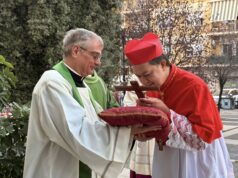HOW DOES one address a cardinal?
Well, it depends. If you are still living in the medieval times when the Pope was regarded as a monarch and his advisers as princes, you addressed him as “Your Eminence.” You would also have to address bishops as “Your Excellency” or “Your Grace,” if he heads a Metropolitan province.
But we are not living in those times anymore, are we? These titles are a thing of the past. And those who cling to them continue to live in the past.
If we go further back to the real past on which the Church is founded—on Jesus and the apostles—you would know how inconsistent these titles are with Jesus of Nazareth. He told his disciples not to imitate the Pharisees who “wear their phylacteries and lengthen their tassels…love places of honor at banquets, seats of honor…greetings…and titles…” (Mt 23:6-7)
He immediately admonished the two young disciples who were aspiring for titles of honor. He said to them in Mk 10:43-45, “It shall not be so among you. Rather, whoever wishes to be great among you will be your servant…”
Apparently, that’s why the cardinals are made to wear red—the color of martyrdom. Those bloody red vestments (pardon the double meaning) are supposed to be a statement that may sound ridiculous to some or even fanatical to others: “I’m a dead man walking. I no longer live for myself. I live only for Christ. These robes are washed by the blood of Christ.”
“How would you like to be addressed?” This was asked by the facilitator of our work group at the Synod. Nobody gave a title; just a first name. So, I said, call me Ambo, like the “ambo” of the Church, the stand from which the Word of God is proclaimed. That’s what my ministry as Bishop is essentially about.
But I also know that in the Asian culture, people would feel awkward to address an elderly person by first name. By adding a relational designation to the person we’re addressing we can actually call them by name. Like Ate Viring, Kuya Mike, Tito Maning, Tita Mila, Nanay Linda, Tatay Mar, Lolo Ponsing, Lola Iska. They are not titles for us; they’re an expression of how we relate with them and who they are in our lives.
That’s why “Father” is not really a title for us; “Reverend” is. To call a priest “Father Edgar” is an endearing gesture. “Bishop” is not regarded as a title; “Most Reverend” is. To call your bishop “Bishop Rene” is an endearing gesture. “Cardinal” is not a title, “Eminence” is. To call Cardinal Tagle “Cardinal Chito” is an endearing gesture. Pope is not a title; “Your Holiness” is. You see, even the Supreme Pontiff of the Catholic Church is simply called “Papa,” to stress his role in the Church as a father. So, we endearingly call him Pope Francis, or Holy Father, not “His Holiness, the Supreme Pontiff.” He himself simply refers to himself as “Bishop of Rome” and signs his name simply as Franciscus or Francis. He never forgot how Filipinos called him “Lolo Kiko.”
The retired Cardinal Gaudencio Rosales was fondly called “Lolo Dency,” meaning Grandfather Dency. I wouldn’t mind being called that, but maybe in my native Kapampangan: “Apung Ambo.” If you want me to frown at you, call me “Eminence.” If you want me to smile at you, just call me “Apung Ambo.”
If you want to be a bit formal, call me by my ministry—Bishop Ambo. That is the ministry which I was ordained for. (There is no ordination for a bishop if he becomes a cardinal. He remains a bishop.) Even the Pope is basically just a bishop, like all other bishops. It’s just that his being bishop of Rome and successor of Peter gives him the responsibility of “presiding over his brother bishops in charity.” We bishops are all just that—servants of God. And the pope, who is called a Supreme Pontiff, is the servant of the servants of God, and is expected to be “the supreme bridge-builder.” That is what Supreme Pontiff means—keeper of the communion of the universal Church.
When the Pope names a brother bishop a “Cardinal,” it means he’s asking him to help in carrying out his “bridge-building task.” That can only be done with a lot of KENOSIS—self-emptying, that attitude that Jesus expects of his friends when they are given a share in his mission. (Philippians 2:1-11) this is the attitude that says “there has to be less of me for there to be more of him. It’s Jesus at work, and he’s only asking us to participate in his life and mission.”
Our motto should be that of St. John the Baptist, who calls himself the Friend of the Bridegroom — “He must increase; I must decrease.” (Jn 3:30)
From here on I will take seriously the little advice Pope Francis gave me when I met him the other day and had the gall to complain and say to him “You should have at least given me an advanced notice!” He said, “Tomátelo con un granito de humor divino.” Take it with a little grain of divine humor.
I will also keep in mind what he said in his letter to our batch of 21 whom he’s calling to a Consistory on December 7: “…I assure you of my prayers that the title of ‘servant’ will increasingly eclipse that of ‘eminence’.”





